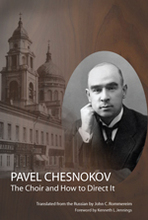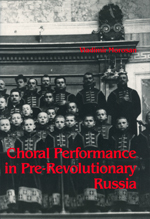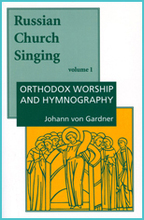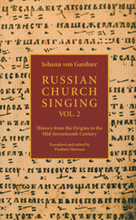Books


|
The Choir and How to Direct It Translated from the Russian by John C. Rommereim. Foreword by Kenneth L. Jennings Musica Russica 978-0-9701767-3-8 lxviii + 266 pp. Cn-CHD Download Table of Contents. Download Chapter 1.
From Russia's leading choral musician of his day, a unique view into the famed Russian a cappella style. Conceived in the 1910s, completed in 1930 and first published in Russia in 1940, Chesnokov's pioneering treatise on the choral art is both a significant historical document and valuable resource for choral musicians today. One does not usually expect choral treatises to be best-sellers, but in the Soviet Union in 1940, when Pavel Chesnokov's The Choir and How to Direct It first appeared in print, it sold out within a matter of hours. The book's popularity later led to two subsequent Russian editions in 1952 and 1961. Now decades later, this is the first translated publication of the book outside of Russia ever to appear. With deep insight and in great detail, this book reveals how to achieve the ideal a cappella choir sound through ensemble, intonation, and nuance.In addition, readers will learn the steps a conductor must take to achieve true choral artistry thorough analysis and mastery of the score, a systematic approach to rehearsal technique, meaningful conducting gestures, as well as inspired communication and leadership.
This item is temporarily out of stock.
|

|
Choral Performance in Pre-Revolutionary Russia Musica Russica Originally published by UMI Research Press, 1986; Musica Russica, 2nd edition, 1994 0-9629460-2-8 (pbk) 396 pp ChP If you've bought the music, now you can read the book that tells you how to perform it authentically! Now in its fourth printing, Choral Performance in Pre-Revolutionary Russia stands as the definitive English-language resource on all aspects of Russian choral music. The first three chapters focus on the history and development of choral singing in the land of Rus', from its origins in the form of unison chant, received from Byzantium, through the rise of indigenous Russian polyphony in the Middle Ages, the coming of Western-style polyphony, and the emergence of the modern-day Russian choral tradition, spearheaded by the Imperial Court Chapel and the Moscow Synodal Choir. The subsequent four chapters discuss choral and vocal training, including ideals of choral tone; prominent conductors, such as Vasily Orlov, Nikolai Danilin, Alexander Arkhangelsky, and Pavel Chesnokov; and the stylistic categories of Russian choral music, both sacred and secular. The final chapter takes up the various aspects of performance practice problems in the manner of Robert Donington, citing relevant passages from period sources: included are sections dealing with pitch, rhythm and meter, tempo, articulation, dynamics, syllabic and recitative chant, soloists, pronunciation and diction, performance context, and interpretation. |

|
Russian Church Singing - Volume 1: Orthodox Worship and Hymnography Translated from the Russian by Vladimir Morosan St. Vladimir's Seminary Press 978-0-913-83659-0 196 pp RCS 1 An essential introduction to the musical aspects of Orthodox Christian worship and liturgy by one of the leading scholars in the 20th century. Describes the structure of Orthodox services, various categories of hymns, and the different styles of performing them. Enumerates the various types of chant used in the Russian Church and gives an outline of the history of church music in Russia.
This item is temporarily out of stock.
|

|
Russian Church Singing - Volume 2: History from the Origins to the Mid-Seventeenth Century Translated from the Russian by Vladimir Morosan St. Vladimir's Seminary Press 978-0-881-41046-4 396 pp RCS 2 The present volume is the second installment of Professor Johann von Gardner's monumental work to appear in English translation. The 400-page volume, translated and edited by Dr. Vladimir Morosan, considers the development and practice of liturgical chant in the Russian lands from a variety of aspects: its origins and the various cultural influences upon its formation; extant manuscripts; the evolution of the notation and the problematics of deciphering it into modern-day notes; the forces involved in its performance; its stylistic evolution from exclusively monodic forms to improvised and, eventually, notated polyphony; its earliest known composers and performing ensembles; its aesthetics in relation to the liturgy, the language, and the various problems that arose over the centuries, resulting in the adoption of Westernized stylistic models around the year 1650, which marks the approximate end of the time period covered in this volume. Much of this information is made accessible for the first time to the English reader, and will be of interest both to the specialist and to the general reader, generating a healthy demand for further research and exploration into this fascinating and hitherto unknown field. |

|
Gift Certificate $25.00 Gift-25 |
